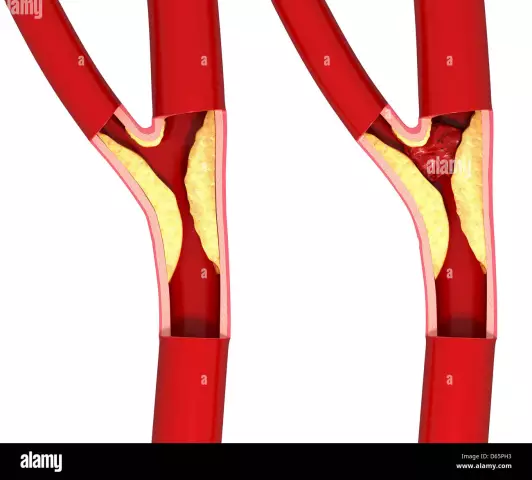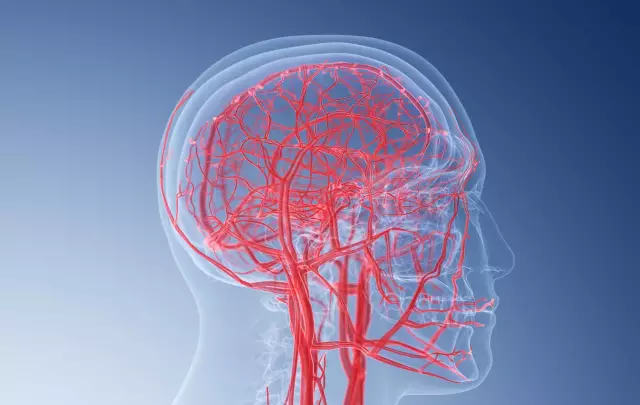- Author Rachel Wainwright [email protected].
- Public 2023-12-15 07:39.
- Last modified 2025-11-02 20:14.
Atherosclerosis of cerebral vessels
The content of the article:
- Causes and risk factors
- Symptoms of atherosclerosis of the brain
- Stages of cerebral atherosclerosis
- Diagnostics
- Treatment of cerebral atherosclerosis
- Potential consequences and complications
- Forecast
- Prevention
Atherosclerosis of the cerebral vessels is a disease of the arteries of the brain, in which foci of lipid (mainly cholesterol) deposits - atherosclerotic plaques - form on their inner membrane. As a result, a progressive narrowing of the arterial vessels develops, up to their complete obliteration.

The main reason for the development of atherosclerosis of the brain is the deposition of atherosclerotic plaques
The disease is widespread. In many cases, the pathological process begins already at the age of 25-30, but since it is characterized by a long subclinical course, the manifestation occurs much later, as a rule, after 50 years.
Atherosclerotic processes in the cerebral vessels account for 20% of all neurological pathology and approximately 50% of all cases of vascular diseases. The disease is 5 times more likely to affect men than women.
Chronic cerebral ischemia caused by atherosclerosis can cause dementia and stroke. Considering the high risk of such complications, as well as the widespread prevalence of cerebral atherosclerosis, experts consider it as one of the global problems of modern angiology and neurology.
Causes and risk factors
The risk factors for atherosclerosis are extensive. Age is one of the most important. To one degree or another, cerebral atherosclerosis is detected in every person over 40 years old. An earlier appearance of the disease and its rapid progression are facilitated by:
- metabolic disorders (hormonal imbalance, thyroid disease, diabetes mellitus, obesity);
- unbalanced nutrition (the predominance of fried and spicy foods, animal fats in the diet, as well as an insufficient content of foods rich in fiber);
- abuse of alcoholic beverages;
- smoking;
- sedentary lifestyle.
Other factors that increase the risk of developing cerebral atherosclerosis are:
- arterial hypertension (often these two pathologies occur simultaneously, potentiating each other);
- chronic intoxication and infections that have a damaging effect on the vascular endothelium;
- often repeated psycho-emotional stress.

Prerequisites for the development of atherosclerosis - improper diet, smoking, sedentary lifestyle
In the development of atherosclerotic changes, apparently, a hereditary predisposition also plays a role.
The presence of numerous risk factors suggests the polyetiology of atherosclerosis.
The main role in the pathological mechanism of the development of the atherosclerotic process is played by the violation of lipid metabolism, as a result of which the concentration of low-density lipoprotein cholesterol in the blood, the so-called bad or harmful cholesterol, increases, and its deposition begins on the inner walls of arteries, including the arteries of the brain. It is still not clear why in some patients the atherosclerotic process mainly affects the vessels of the brain, while in others the coronary, mesenteric or peripheral arteries.
Cerebral atherosclerosis mainly affects medium and large arteries. Initially, an atherosclerotic plaque is a fatty spot, which is further saturated with calcium salts (atherocalcinosis) and increases in size. Formed atherosclerotic plaque not only blocks the inner lumen of the blood vessel, but also becomes a potential source of thromboemboli.
Reducing the lumen of the cerebral arteries reduces blood flow to the areas of the brain that feed them. As a result, chronic hypoxia and ischemia develop in these areas, which eventually cause the death of individual neurons. This pathological process is clinically manifested by signs of discirculatory encephalopathy, the severity of which is determined by the following factors:
- the caliber of the affected cerebral artery;
- the degree of spread of the atherosclerotic process;
- the size of the atherosclerotic plaque;
- the degree of collateral (bypass) blood circulation in the zone of chronic cerebral ischemia.
As the atherosclerotic plaque grows, it creates conditions for the formation of blood clots (thrombi), which can break off and enter the smaller cerebral arteries with blood flow, completely blocking their lumen. Complete and sudden cessation of blood supply to a certain area of the brain leads either to the development of ischemic stroke or to a transient ischemic attack (determined by the degree of development of the collateral network of blood vessels and the size of the lesion).
The arterial wall in the area of atherosclerotic plaque attachment loses its elasticity over time. With an increase in blood pressure, for example, against the background of a hypertensive crisis associated with arterial hypertension, it can rupture with the formation of bleeding into the brain tissue, i.e., hemorrhagic stroke.
Symptoms of atherosclerosis of the brain
For many years, atherosclerosis of the cerebral vessels is asymptomatic or with minimal severity. Clinically, the disease begins to manifest itself only when the atherosclerotic plaque increases enough to significantly block the blood flow, leading to ischemia of brain tissue and the development of discirculatory encephalopathy.

Clinical signs of cerebral atherosclerosis appear when an atherosclerotic plaque blocks blood flow
Stages of cerebral atherosclerosis
In the clinical picture of cerebral atherosclerosis, three stages are distinguished:
- Initial. Symptoms of the disease occur against the background of physical or psycho-emotional overload. After a good rest, they completely disappear. Many patients have asthenic syndrome: fatigue, general weakness, irritability or lethargy, problems with concentration. In addition, patients complain of frequent headaches, which can be combined with tinnitus, as well as a deterioration in the ability to remember new information, a decrease in the rate of thought processes.
- Progressive. Psychoemotional disorders are growing. The general background of mood is reduced, a depressive state often develops. Memory disorders become clearly pronounced: patients, according to relatives, do not remember the latest events, they often confuse them. The noise in the ears and head becomes constant. Blurred speech, vestibular ataxia (specific impairment of coordination of movements and gait) are noted. In some cases, there may be some hearing loss, decreased visual acuity, tremor of the head or fingers. The ability for full-fledged professional activity is gradually lost. Patients become anxious and suspicious.
- Dementia. Symptoms of atherosclerosis of the cerebral vessels at this stage of the disease are memory lapses, slovenliness, speech disorders, a complete disappearance of interest in the events of the surrounding world (apathy). Patients lose self-care skills, cannot correctly orient themselves in time and space. As a result, they not only completely lose their ability to work, but also need constant outside care.

Stages of development of cerebral atherosclerosis
Diagnostics
During neurological examination of patients with cerebral atherosclerosis, the following are determined:
- tremor of the fingers;
- violation of coordination tests;
- instability in the Romberg position;
- symmetrical lethargy or, conversely, a symmetrical increase in reflexes;
- some anisoreflexia (different severity of skin and tendon reflexes on the right and left side of the body);
- horizontal nystagmus;
- paresis of the gaze upward.
If a patient with cerebral atherosclerosis has suffered a stroke, he will develop paresis and other neurological deficits.
When examining the fundus, an ophthalmologist detects atherosclerotic changes in the retinal arteries. Patients with complaints of hearing loss and tinnitus are referred to an otolaryngologist for consultation.

One of the methods for diagnosing atherosclerosis of cerebral vessels is MRI of the brain
Also, when diagnosing atherosclerosis of cerebral vessels, laboratory and instrumental examination is carried out, including:
- rheoencephalography;
- USDG of head vessels;
- magnetic resonance imaging of the brain;
- electroencephalography;
- blood test for total cholesterol, lipids, triglycerides.
Treatment of cerebral atherosclerosis
Atherosclerosis of the cerebral vessels is a chronic disease that cannot be completely cured. Nevertheless, complex and regular therapy can slow down its further progression.
Treatment of cerebral atherosclerosis begins with the elimination of factors that potentiate the appearance and increase in the size of atherosclerotic plaques. For this purpose, it is recommended:
- adherence to a diet (table number 10c according to Pevzner);
- a sufficient level of physical activity (swimming, walking, physical therapy);
- refusal to drink and smoke;
- optimization of body weight;
- decrease in the level of psycho-emotional stress.
The diet for atherosclerosis of the cerebral vessels is based on excluding foods with a high cholesterol content (sausages, canned fish, margarine, eggs, fatty meat) from the diet and enriching it with fresh vegetables and fruits, that is, foods containing fiber.

With atherosclerosis, the diet includes foods that lower cholesterol levels
Medical treatment of cerebral atherosclerosis is aimed at improving blood supply and metabolism of brain tissue, increasing its resistance to conditions of oxygen starvation, preventing embolic complications and improving intellectual and mental functions.
When atherosclerosis of the cerebral vessels is combined with arterial hypertension, it is necessary to carefully select drugs for antihypertensive therapy that ensure the normalization of blood pressure.
To correct the lipid spectrum of blood serum, in the presence of indications (determined by the results of a biochemical study), hypolipidemic drugs are prescribed.
In order to reduce blood viscosity and reduce the risk of thromboembolic complications, small doses of acetylsalicylic acid (Aspirin) or Tiklid are prescribed for a long course.
Neurometabolic therapy includes drugs based on ginkgo biloba, glycine, a complex of B vitamins. Nootropic drugs contribute to improving mental abilities and memory.
Indications for surgical treatment of cerebral atherosclerosis are:
- decrease in the lumen of the carotid arteries by atherosclerotic plaque by more than 70%;
- past minor stroke in history;
- repeated transient ischemic attacks.
There are several methods of surgical treatment of cerebral atherosclerosis:
- removal of an atherosclerotic plaque with a portion of the intima of a blood vessel (endarterectomy);
- creation of a vascular shunt, allowing to restore blood flow bypassing the area clogged with atherosclerotic plaque;
- prosthetics of the brachiocephalic trunk;
- formation of extra-intracranial anastomosis;
- carotid endarterectomy.
Potential consequences and complications
Atherosclerosis of the cerebral vessels can be accompanied by the development of the following complications:
- transient disorders of cerebral circulation;
- ischemic stroke;
- hemorrhagic stroke;
- depression;
- dementia.
Forecast
The prognosis for atherosclerosis of the cerebral vessels is determined by a number of factors, including the possibility of eliminating risk factors, the age of the patient, and the timeliness and systematic nature of treatment. With timely diagnosis and early start of treatment, it is possible to significantly slow down the progression of the atherosclerotic process. The development of complications (stroke, dementia) becomes the cause of permanent disability and can lead to death.
Prevention
The best prevention of atherosclerosis is a healthy lifestyle, which means:
- balanced diet;
- moderate but regular physical activity;
- observance of the rhythm of alternation of work and rest;
- regular stay in the fresh air;
- avoidance of both physical and psycho-emotional overstrain.
In cases where cerebral atherosclerosis has already developed, measures are taken to slow the progression of the pathological process and prevent the development of complications. They include careful adherence to the recommendations of the attending physician, regarding both drug therapy and lifestyle, and, if necessary, timely implementation of surgical intervention that restores blood supply in the affected artery basin.
YouTube video related to the article:

Elena Minkina Doctor anesthesiologist-resuscitator About the author
Education: graduated from the Tashkent State Medical Institute, specializing in general medicine in 1991. Repeatedly passed refresher courses.
Work experience: anesthesiologist-resuscitator of the city maternity complex, resuscitator of the hemodialysis department.
The information is generalized and provided for informational purposes only. At the first sign of illness, see your doctor. Self-medication is hazardous to health!






